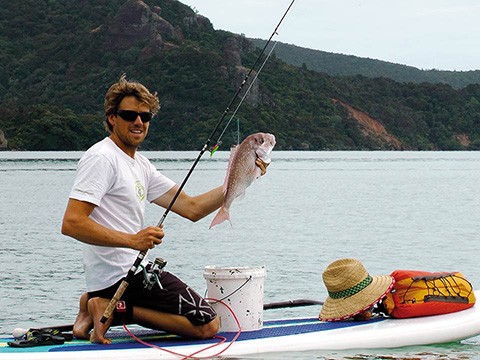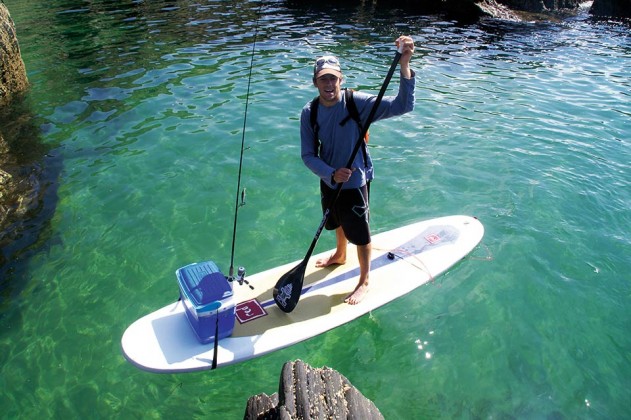Buy a man a stand-up paddle board and you might not see him on weekends. Teach him how to fish, and you’ll never see him again, or so the ancient proverb tells us. It’s funny to think that when we’re paddling around, we’re cruising above the largest food store in nature. Here’s how to transform a pedestrian flat water trundle into a rod-buckling morning of action…
Words and photos: Reuben and Lucy @ suprental.co.uk
(This feature originally appeared in the Spring 2012 issue of SUP International. Print and digital subscriptions for readers worldwide are available HERE.)
SETTING UP YOUR PLATFORM
You’ll need a nice big floaty board, I normally go out on my Red Air TenSix. Atop this you will place a mid -sized coolbox that’s no wider than your board. This makes a great seat, snack box and hopefully a place to put all your fish. Next, find a piece of 1’’1/2 waste pipe, about 1 foot long and tape it or tie it, to the outside of your coolbox; this is your rod holder. Then make a fixing strap that can go around the bottom of your board (an old roof rack strap is ideal). Attach the strap in a way so you can still easily open your coolbox.. Have a play around with the set up, putting the coolbox at the front and the back of the board to find out which position suits you best.
You’ll also need a small waterproof backpack or container to carry a few extra things. I always take a small amount of spare tackle, a mobile phone, a pair of pliers, a small knife, and some food and water. Oh yeah, and also a mate to keep me company. It’s also always worth telling someone else where you’re going and when you will be back.
FISHING METHODS
When SUP fishing, the best techniques are usually spinning, plugging or using feathers. The last thing you want to have to deal with on your SUP is bait. You can use a small spinning rod or a hand line. The advantage of a rod is that you can cast into small bays and around rocky out crops. However a hand line is the easiest to take… just put it in your pocket and go paddling.
Trolling is a great way of catching fish and going for a decent paddle all at the same time. Cruise along the coast at about 2knots trolling a plug or spinner at about 30m behind your SUP. You can use weighted feathers but be careful not to catch the bottom. It’s best to stay in deep water about 15m +. Coloured feathers are the best for trolling. The other way to fish with feathers is to jig. Paddle out to a deep area of water and pull your feathers up and down on the spot. This is a really good way to catch mackerel. Feathers with the colour silver in them are best for this.
Plugging is the term used when fishing with a lure with a plastic angled front to it. As the plug is pulled though the water it gets forced down. Different plugs are made for different depths. The best plug for SUP fishing is one that dives to approx 2m. Plugging is good for both casting and trolling. And plugging is perfect for SUP fishing because most plugs float and therefore when you stop paddling they don’t sink and get caught on the sea bed. This is my preferred fishing method, and many large fish can be caught this way. Spinning is fishing with a weighted, silver piece of metal, aka the spinner. A spinner is excellent for casting or trolling. But remember it will sink and easily get caught on the sea bed so don’t stop paddling.
 YOUR QUARRY AND WHERE TO FIND IT
YOUR QUARRY AND WHERE TO FIND IT
The fish you will commonly expect to catch when you are SUP fishing in temperate regions during are Bass, Mackerel, Pollack and Wrasse. They are all good eating fish apart from Wrasse which is a bit flavourless and boney. The type of fish you are likely to catch really depends on where you are fishing. Fish don’t just swim around aimlessly; they are in certain spots for a reason, normally because there is food and some protection from predators. So the first thing you need to figure out is which fish are where.
BASS
Bass are by far the best fish to eat, but are often thought to be the hardest to catch. SUP fishing is definitely one of the best ways to catch Bass because the places Bass generally hang out are easily accessible by paddleboard. Bass go to little sandy bays and rocky outcrops to hunt for food like sandeels, sprats, worms, crustaceans and small fish. By using a SUP to fish, you can not only get to these fishing areas easily but you are also less likely to scare the fish away as you can approach with great stealth. Smaller Bass are call schoolys because they are found in groups (schools) and are generally run up to 2 1/2 lb. Large Bass are usually more solitary. Bass are most active in the morning and evening. They will also feed more aggressively if the water visibility is bad, because there is less chance of them being eaten by predators like gannets, cormorants and seals. Handily, Bass have very good eyesight so they will still be able to see your lure in the water. On a day with clear skies and good water visibility they are harder to get to bite and therefore catch and most fish are like this. Bass are slow growers, so there is a minimum keep size of 37.5 cm in the UK at the moment. It’s very important to keep to the size limit to ensure there are more fish in the future and plenty for all of us to enjoy.
Bass Tip: Look out for the rocky outcrops surrounded by a sandy bottom.
Bass Warning: Bass have very sharp gill plates and spikes on fins, use a gardening glove.
MACKEREL
Mackerel are good eating fish and also good fun to catch, as they can be found everywhere. They are found mainly in large schools in deep water. They are more aggressive feeders in the morning and evening but if they are in the area you are fishing you will catch hook a few. If you catch one or two, get your line back in the water asap because there are likely to be more around.
Mackerel Tip: Don’t fish using a feather with more than three hooks unless you want to have to deal with lots of mackerel, all at once, on your SUP.
POLLACK
These are the fish you will probably catch the most of. They are good to eat (but not as a good as Bass) so many restaurants are now serving Pollack. Pollack are found in the same area as Bass but usually in the more weedy areas. Fish for them the same way as Bass. If you’re catching Pollack then it’s a good sign because it means the fish are on the feed and so you are likely to catch Bass too – you just need to find them!
Pollack Tip: Find weedy rock gullies in the early evening.
For SUP rental in the South West UK, contact Reub’s and Lucy at www.suprental.co.uk SUP

